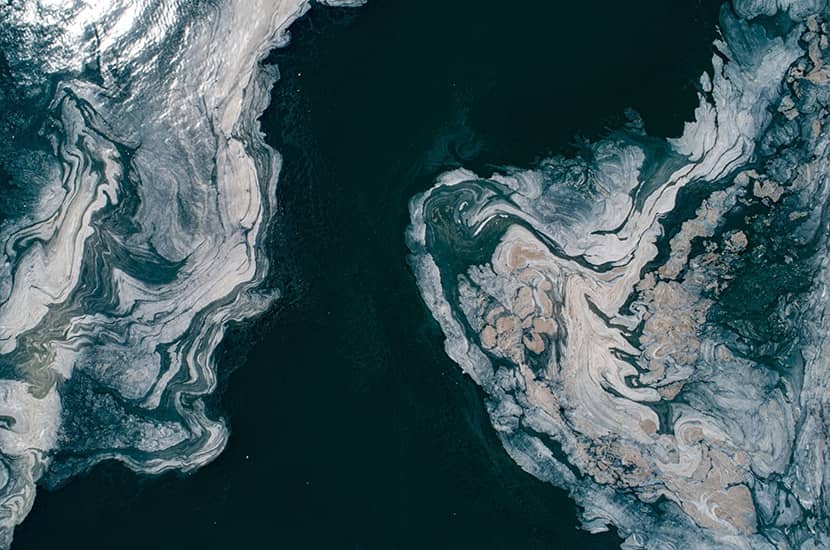As humans, we are supposed to have an aversion to slime. It should repel us. Objects and organisms that might be harmful trigger feelings of disgust which keep us away. And, according to the biologist Susanne Wedlich, the common denominator of ‘wide-ranging microbial threats, covering sickness, sex, death and putrefaction’ is their sliminess. It is easy to test this theory. Google ‘slime moulds’ and note your first response. They are gross.
But these organisms are worth sticking with. Japanese researchers once conducted an experiment using a slime mould and a map of the country. They put the mould on top of Tokyo and dropped food on to the city’s surrounding towns. A little while later the mould had left a trail that closely replicated the city’s underground system. It had figured out the same efficient way to travel as the city’s planners.
Slime is found in the most extreme habitats: hot springs, icebergs, active volcanoes and radioactive water
Disgust is a blunt instrument, however, designed only to keep us safe. This means we pay less attention to slime and know less about it than we should. This is the thrust of Wedlich’s book, which persuades us to hold our gaze on something we are pre-programmed to look away from. She argues convincingly that slime is ubiquitous, essential and a threat to life on our planet.
It is found in the most extreme habitats, from hot springs to frozen icebergs, active volcanoes to radioactive water. It enables biological processes that you didn’t know were ongoing and keeps out pathogens that you didn’t know existed. It is everywhere. The surface of the oceans comprises a layer of slime a fraction of a millimetre thick, known as the sea-surface microlayer, or SML.
This layer is made up of a carpet of marine nutrients which attracts microbes that form slimy biofilms as they consume their food. One suspects that the state of the SML will be of considerable importance in the fight to limit climate change, given that the oceans absorb around half of all greenhouse gas emissions and that all of those have to pass through the SML. Wedlich argues that we know remarkably little about the microlayer because it is ‘too vast, too thin and too changeable’ for major study. What we do know is that initiatives to limit ocean plastic, such as skimming the surface with fine nets, remove lots of plastic but also take away up to 90 per cent of the SML. The consequences of damaging the layer in this way are still unknown.
There is a remarkable parallel on land, too. In the world’s dry spots, its deserts, steppes and savannahs, the top layer of soil is bound together into invisible crusts by cyanobacteria, which build sticky matrices of sand, soil and water. When undisturbed, these communities can draw in fungi, mosses and arthropods to become complex communities. These crusts matter because they break down nitrogen into components that plants can absorb. Yet biologists believe that soil crusts are under threat not just from global heating but also the transformation of savannah into farmland to feed a growing population. Taken together, the slimy top layers of the oceans and the soil cover almost 80 per cent of the total surface of the planet, yet no one but marine biologists and agronomists are even aware that they exist.
Slime is packed with disarming facts such as these, set alongside innumerable examples of how the natural world uses slime in a variety of creative ways. (Mudskippers, amphibious fish, can live on land for several days at a time thanks to secretions of slime that protect their skin from abrasions.) Wedlich is a modest and understated guide; she could shout louder about the enormous gaps in our knowledge.
She is also too fond of the single trick, of beginning each chapter with an anecdote of something intended to be similar to slime. When this works, it is a neat and appropriate aid. The comparison between Albrecht Durer’s 16th-century designs for fortified cities and the ways our bodies use slimy membranes and hydrogels to protect ourselves from bacteria and viruses is insightful. But laboured references to Pirates of the Caribbean, the New York City Fire Department and Woody Allen are discursive and distracting. There is enough going on in the world of slime for it to hold our attention alone.
Indeed, Wedlich theorises that we might be at some sort of slimy inflection point. For three billion years, slime ruled the Earth. Nothing lived on land, while the bottoms of the oceans were covered in thick microbial mats that sealed off the microbes inside from the water above. Some evolutionary biologists called the last phase of this period ‘the boring billion’, as the planet was climatically and tectonically stable. Wedlich disputes this characterisation, citing that it was under the mats that the first multicellularity and sexual reproduction took place. It was not boring: it was a ‘slingshot’ for life. We don’t know the outcome of the ongoing, human-generated loss of marine species. Some scientists believe the ocean floor could again be taken over by slime. Wedlich makes the case for us paying closer attention.






Comments